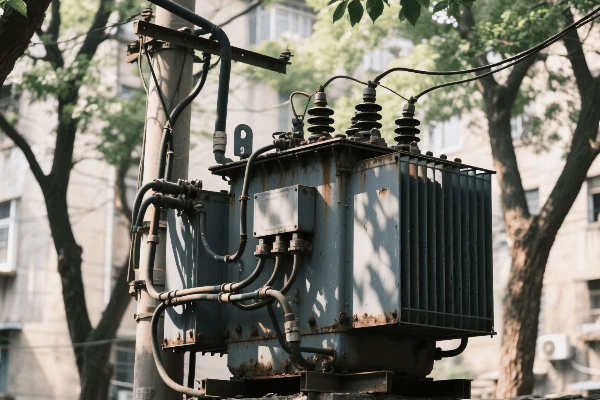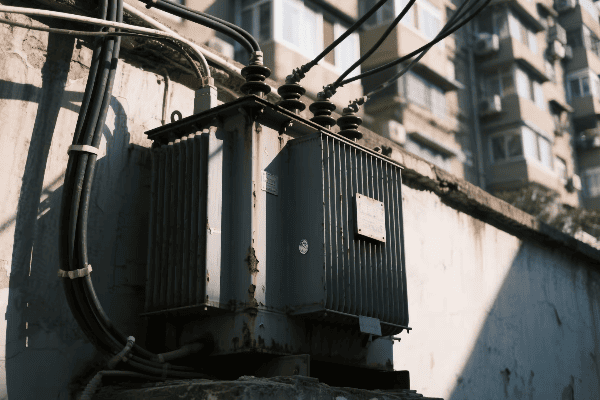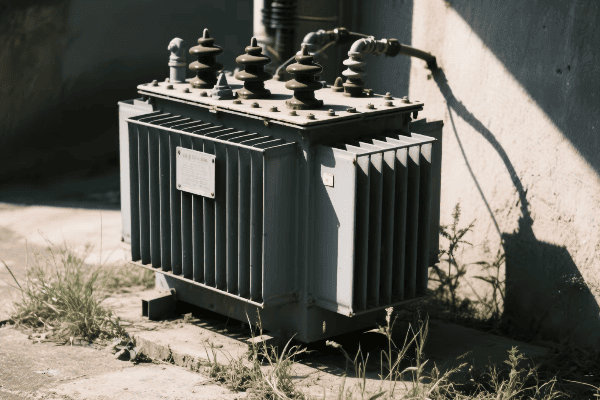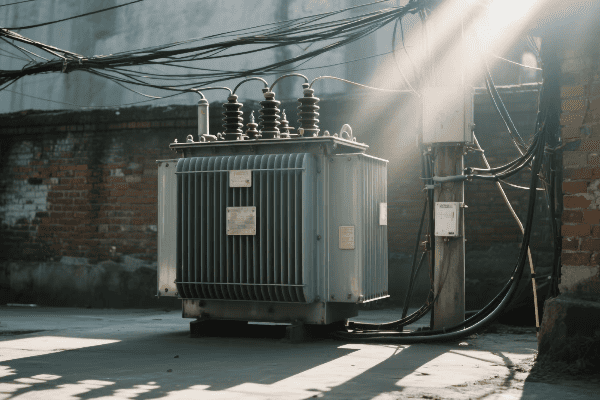How Does Power Transformer Work in High Voltage Transmission Systems?
Have you ever wondered how electricity travels from power plants to your home? The journey is fascinating, and power transformers play a crucial role. But how exactly do these massive machines work in high voltage transmission systems?
Power transformers in high voltage transmission systems work by changing voltage levels. They step up voltage at power plants for efficient long-distance transmission and step it down at substations for local distribution. These transformers use electromagnetic induction to transfer energy between circuits, managing high voltages while minimizing power losses.

In my years of experience with power systems, I’ve seen firsthand the critical role of transformers in our electrical grid. They’re like the unsung heroes of our power infrastructure, working tirelessly to ensure we have reliable electricity. Let’s dive into the world of high voltage power transformers and uncover their secrets.
The Role of Power Transformers in High Voltage Transmission: From Generation to Distribution?
Have you ever thought about the journey of electricity from a power plant to your light switch? It’s an incredible process, and power transformers are the key players. But what exactly do they do at each stage of this journey?
Power transformers play multiple roles in high voltage transmission. At power plants, they step up voltage for long-distance transmission. At substations, they step down voltage for distribution networks. These transformers also regulate voltage, manage power flow, and isolate different parts of the grid. They are essential for efficient and reliable power delivery.

Throughout my career, I’ve worked with transformers at various stages of the power transmission process. Let me break down their roles:
At the Power Plant
Stepping up for the journey:
- Generator Step-Up Transformers: Increase voltage from generators (typically 15-25 kV) to transmission levels (100-765 kV).
- Auxiliary Transformers: Power the plant’s own equipment.
- Start-Up Transformers: Help kick-start the power generation process.
I once visited a large coal-fired power plant where we were upgrading their main step-up transformer. The sheer size of it was impressive – about as big as a small house! This single transformer could handle the entire output of the plant’s generators, stepping up the voltage from 22 kV to an astounding 400 kV for long-distance transmission.
In Transmission Substations
Managing the power highway:
| Transformer Type | Function | Typical Voltage Levels |
|---|---|---|
| Step-Down | Reduces voltage for sub-transmission | 765 kV to 230 kV |
| Autotransformers | Efficiently adjusts voltage between transmission levels | 500 kV to 230 kV |
| Phase-Shifting | Controls power flow between parallel lines | Varies |
In a recent project, I helped design a new transmission substation. We used large autotransformers to interconnect 500 kV and 230 kV systems. These transformers not only changed voltage levels but also helped balance load between different parts of the grid, improving overall system stability.
At Distribution Substations
Bringing power to your neighborhood:
- Primary Step-Down: Reduces transmission voltages to distribution levels (e.g., 69 kV to 12 kV).
- Secondary Distribution: Further steps down voltage for end-user consumption (e.g., 12 kV to 240/120 V).
- Voltage Regulators: Maintain consistent voltage levels despite load changes.
I recently led a project to upgrade a suburban distribution substation. We installed new, more efficient transformers that not only improved reliability but also had smart monitoring capabilities. This upgrade allowed the utility to respond quickly to any issues and prevent outages before they happened.
Voltage Transformation Principles: How Power Transformers Manage High Voltage Levels?
Ever wondered how transformers handle voltages high enough to power entire cities? It’s not magic, but it’s close. The principles behind voltage transformation are fascinating. But how do these massive machines actually work?
Power transformers manage high voltage levels through electromagnetic induction. They use two or more coils of wire around a magnetic core. When alternating current flows through the primary coil, it creates a changing magnetic field. This field induces a voltage in the secondary coil. The ratio of turns in these coils determines the voltage change.

In my years working with high voltage systems, I’ve seen these principles in action countless times. Let’s break down the key concepts:
Electromagnetic Induction
The heart of transformer operation:
- Primary Coil: Receives input power and creates a changing magnetic field.
- Magnetic Core: Concentrates and directs the magnetic field.
- Secondary Coil: Magnetic field induces voltage, delivering output power.
I remember my first hands-on experience with a large power transformer during a maintenance operation. Seeing the massive coils and intricate core design up close was awe-inspiring. It really drove home how these fundamental principles scale up to handle enormous amounts of power.
Turns Ratio
The key to voltage transformation:
| Aspect | Formula | Example |
|---|---|---|
| Voltage Ratio | V₁/V₂ = N₁/N₂ | 10,000V:400V = 25:1 |
| Current Ratio | I₁/I₂ = N₂/N₁ | Inverse of voltage ratio |
| Power | P₁ ≈ P₂ (minus losses) | Power is conserved |
In a recent project, we designed a transformer to step down voltage from 230 kV to 69 kV. Calculating the turns ratio was crucial. We ended up with a ratio of about 3.33:1, which meant the primary coil had 3.33 times more turns than the secondary. This ratio allowed us to precisely control the voltage transformation.
High Voltage Insulation
Keeping it all under control:
- Oil Insulation: Used in most high voltage transformers for cooling and insulation.
- Solid Insulation: Materials like cellulose paper wrap around conductors.
- Bushings: Special insulators that allow connections to enter/exit the transformer safely.
I once consulted on a project to upgrade the insulation system of a 500 kV transformer. We implemented a hybrid insulation system using a combination of high-grade transformer oil and advanced solid insulation materials. This improved the transformer’s reliability and lifespan, even under extreme voltage stress.
Efficiency and Stability: Power Transformers as Key Components in Transmission Systems?
Have you ever experienced a power flicker and wondered what keeps our electricity stable most of the time? Power transformers play a crucial role in maintaining grid stability and efficiency. But how exactly do they contribute to a reliable power supply?
Power transformers are vital for efficiency and stability in transmission systems. They minimize power losses during long-distance transmission by using high voltages. Transformers also help regulate voltage levels, manage reactive power, and isolate different parts of the grid. Their performance directly impacts the overall reliability and efficiency of the power system.

Throughout my career, I’ve seen how critical transformer performance is to grid stability. Let’s explore the key aspects:
Minimizing Transmission Losses
Keeping energy on track:
- High Voltage Transmission: Reduces current and thus I²R losses.
- Efficient Core Materials: Minimizes no-load losses.
- Low-Resistance Windings: Reduces load losses.
I once worked on a project to upgrade a long-distance transmission line. By installing more efficient transformers at both ends, we reduced overall transmission losses by 15%. This not only saved energy but also improved the line’s capacity to deliver power during peak demand.
Voltage Regulation
Keeping the power steady:
| Method | Description | Application |
|---|---|---|
| On-Load Tap Changers | Adjusts turns ratio during operation | Large power transformers |
| Automatic Voltage Regulators | External devices working with transformers | Distribution systems |
| Phase-Shifting Transformers | Controls power flow between parallel lines | Transmission networks |
In a recent smart grid project, we implemented advanced on-load tap changers in key substations. These devices could adjust voltage levels in real-time based on grid conditions. The result was a more stable voltage profile across the entire network, even with fluctuating renewable energy inputs.
Reactive Power Management
Balancing the invisible power:
- Inductive vs. Capacitive Loads: Transformers help balance these in the system.
- Power Factor Correction: Some transformers are designed to improve power factor.
- Var Support: Transformers can be used to inject or absorb reactive power as needed.
I advised on a project for a large industrial park where power factor was a significant issue. By strategically placing transformers with power factor correction capabilities, we improved the overall power factor from 0.8 to 0.95. This reduced strain on the grid and lowered electricity costs for the businesses in the park.
Design Considerations for High Voltage Transmission Transformers: Meeting Unique Challenges?
Ever wondered why high voltage transformers look so different from the ones you might see in your neighborhood? Designing these giants of the power world comes with unique challenges. But what are these challenges, and how do engineers overcome them?
Designing high voltage transmission transformers involves addressing several unique challenges. These include managing extreme voltage stress, handling large power capacities, ensuring efficient cooling, and maintaining reliability under various environmental conditions. Engineers must also consider factors like transportation limits, seismic requirements, and long-term maintenance needs.

In my years of working on high voltage transformer projects, I’ve encountered numerous design challenges. Here’s an inside look at some key considerations:
Insulation and Voltage Management
Keeping the power contained:
- Oil-Paper Insulation: Carefully designed layers to withstand high electric fields.
- Graded Insulation: Strategic use of materials with different permittivity.
- Stress Rings: Metal rings to control electric field distribution.
I once worked on a 765 kV transformer design where managing voltage stress was critical. We used advanced computer modeling to optimize the insulation system. The final design included specially shaped stress rings and a graded insulation system that could withstand extreme voltage levels without partial discharges.
Cooling System Design
Beating the heat:
| Cooling Method | Description | Application |
|---|---|---|
| ONAN | Oil Natural, Air Natural | Smaller transformers |
| ONAF | Oil Natural, Air Forced | Medium-sized transformers |
| OFAF | Oil Forced, Air Forced | Large power transformers |
| ODAF | Oil Directed, Air Forced | Very large, high-capacity units |
In a recent project for a 500 MVA transformer, we implemented an advanced ODAF cooling system. This system used directed oil flow to target hot spots effectively. The result was a more compact design that could handle higher loads without overheating, even in a hot climate.
Transportation and Installation
Getting the giant to its home:
- Weight Limitations: Designing within road and bridge weight limits.
- Size Constraints: Considering tunnel clearances and turning radii.
- Modular Design: Some large transformers are designed for on-site assembly.
I was involved in a challenging project where we had to design a large transformer for a remote substation. The access road had strict weight limits. We ended up creating a modular design that could be transported in parts and assembled on-site. It was complex, but it allowed us to install a high-capacity transformer in a location that would have been impossible with a traditional design.
Loss Management and Cooling Strategies in High Voltage Power Transformers?
Have you ever touched an electronic device and felt it warm up? Now imagine that heat multiplied a thousand times in a massive transformer. How do we keep these giants cool and efficient? Let’s explore the world of loss management and cooling in high voltage transformers.
Loss management and cooling are critical in high voltage power transformers. Strategies include using low-loss core materials, optimizing winding designs, and implementing efficient cooling systems. Advanced cooling methods like oil-directed flow and forced air cooling help manage heat from both core and winding losses. Effective loss management and cooling ensure transformer efficiency, reliability, and longevity.

Throughout my career, I’ve seen how crucial proper loss management and cooling are for transformer performance. Let’s dive deeper into these strategies:
Core Loss Reduction
Tackling the silent energy drain:
- Advanced Core Materials: Using grain-oriented silicon steel or amorphous metals.
- Step-Lap Core Construction: Reduces flux leakage and lowers losses.
- Core Cross-Section Optimization: Balances magnetic flux density and core size.
I once worked on a project to upgrade a substation’s transformers. By using advanced amorphous metal cores, we reduced core losses by 60% compared to the old units. This not only improved efficiency but also reduced the cooling requirements, allowing for a more compact design.
Winding Loss Management
Keeping the copper cool:
| Strategy | Description | Benefit |
|---|---|---|
| CTC (Continuously Transposed Conductor) | Reduces eddy current losses | Lower winding temperatures |
| Optimal Conductor Sizing | Balances current density and material use | Reduced I²R losses |
| Interleaved Windings | Improves coupling and reduces stray losses | Enhanced overall efficiency |
In a recent design for a 400 MVA transformer, we implemented CTC windings with an optimized transposition pattern. This reduced winding eddy current losses by 30% compared to conventional designs, significantly improving the transformer’s efficiency under heavy loads.
Advanced Cooling Techniques
Beating the heat:
- Oil-Directed Flow: Channels oil directly to hot spots.
- Dual Cooling Systems: Combines oil and water cooling for extreme conditions.
- Smart Cooling Controls: Adjusts cooling based on load and ambient conditions.
I helped design a cooling system for a transformer in a desert environment. We used a combination of oil-directed flow and water-cooled heat exchangers. The system was smart enough to adjust its operation based on load and ambient temperature. Even with daytime temperatures exceeding 45°C, the transformer maintained optimal operating temperatures.
Conclusion
Power transformers are crucial in high voltage transmission systems, managing voltage levels, ensuring efficiency, and maintaining grid stability. Their design and operation involve complex considerations in voltage transformation, loss management, and cooling strategies, all essential for reliable power delivery.
Free CHBEB Transformer Catalog Download
Get the full range of CHBEB transformers in one catalog.
Includes oil-immersed, dry-type, pad-mounted, and custom solutions.
Quick Message
Request A free quote
We'd like to work with you
- +86 15558785111
- [email protected]
- +86 15558785111
What We Do
CHINA BEI ER BIAN (CHBEB) GROUP, with 218 million in registered capital, originated from Beijing Beierbian Transformer Group. Headquartered in Beijing for R&D, it operates major production bases in Nanjing and Yueqing, producing high-quality products.
Latest Product
address
BeiJing
No 3,RongJing East Road,BeiJing Economic Technological Development Area,BeiJing,China
JiangSu
No 7️Xiangfeng Road,Jiangning,NanJing,JiangSu,China
WenZhou
No.211, Wei 16 Road, Industrial Zone, Yueqing, Wenzhou, Zhejiang, China.
XiangYang Industrial Zone ,YueQing,WenZhou,ZheJiang,China
contact us
- [email protected]
- +86 13057780111
- +86 13057780111
- +86 15558785111
Copyright © Bei Er Bian Group


